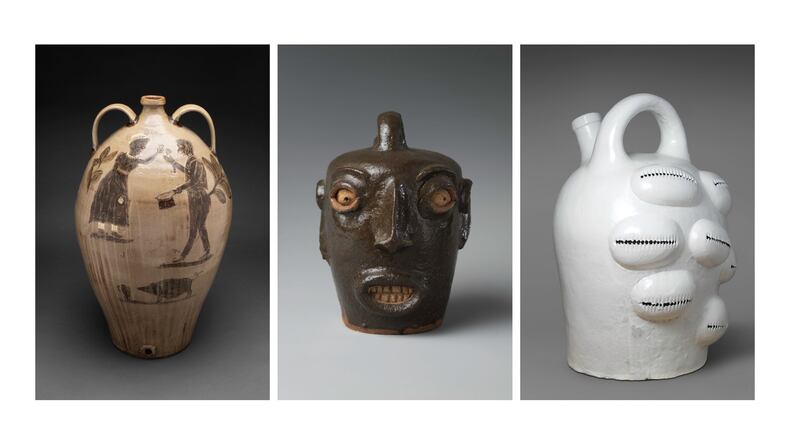Slavery in America is often associated with the image of Black people picking cotton, tobacco or sugar cane in the fields of South Carolina, Georgia, Tennessee or Louisiana.
But a new exhibition at the High Museum testifies to a lesser known stolen labor that arose during slavery: the theft of African traditions, artistry and the intellectual and creative property of enslaved people.
The exhibition “Hear Me Now: The Black Potters of Old Edgefield, South Carolina” is intended, in part, to complicate our understanding of American slavery as strictly agricultural in nature. The traveling exhibition organized by New York’s Metropolitan Museum of Art and the Museum of Fine Arts, Boston, shows how slavery built the country’s wealth on many industrial fronts.
The radical objects in “Hear Me Now” are the clay vessels used, scholars speculate, to store molasses, preserved meats, water and lard. The objects were largely crafted by American slaves in two dozen pottery factories in Edgefield, South Carolina, before the Civil War.
The Old Edgefield district comprised what is known today Aiken, Edgefield, Greenwood, McCormick and Saluda counties. The area was rich in kaolin clay, making it a well-suited site for a thriving pottery industry owned by white Southerners who used Black slave labor to create their products.
Often inscribed with emotionally complicated messages and ornamentation, the vessels speak to the experiences of the people who crafted them and offer an intimate window into their daily lives and experiences. As exhibition co-curator Jason R. Young, associate professor of history at the University of Michigan Ann Arbor, poignantly notes in an accompanying catalogue essay, the massive scale of pottery making in Old Edgefield can be attested to by the shards of broken pottery smashed underfoot as he and other scholars walk the grounds today.
“I felt myself traversing a wasteland, a vast open grave littered with ceramic bones,” he wrote, noting a similarity between fragile, breakable human beings and the clay objects that feel like stand-ins for the people who created them.
In addition to those utilitarian alkaline-glazed jars and pots on display are a collection of face jugs and cups made by the creators for their personal use, including as ornamentation for graves. With their bared teeth, bulging eyes and often fearsome expressions, the face jugs, Young notes, were rooted in West Central African funerary traditions and testify to the creative lineage carried from Africa to America.
“Edgefield is this kind of bridge between history’s aesthetic and cultural traditions in Africa, and aesthetic and cultural traditions in the United States,” said Katherine Jentleson, the High’s curator of folk and self-taught art. She, along with Monica Obniski, curator of decorate arts and design, co-curated the High Museum of Art’s iteration of “Hear Me Now.”
One of the most renowned potters working in Edgefield’s 19th century industry was David Drake, who created monumental “poem jars,” including an almost two-foot vessel displayed along with 10 other Drake works in the show. Drake, whose wife and children were sold by one of his enslavers, often inscribed his pots with terse but emotionally complex messages. As he wrote on one of his vessels: “I wonder where is all my relations / Friendship to all — and every nation.”
“He was really like a local celebrity, and there were newspaper accounts that survive about how people would come to watch him turning a pot,” said Jentleson.
Credit: David Mathews
Credit: David Mathews
Drake’s works were inscribed in an age when literacy among enslaved people was a punishable crime. “These pots were acts of resistance,” said Obniski. “It’s the most radical thing that he was doing in the 19th century.”
Featuring three pieces from the High’s collection of 11 Edgefield vessels, “Hear Me Now” at the High differs from the New York and Boston shows because it includes works from the High’s folk art and decorative arts collections.
The co-curators’ desire, Jentleson said, was to demonstrate “other ways that Black creativity and creative resilience survived enslavement” and to highlight the High’s unique holdings within Southern craft and decorative traditions. Among the additions is a sweetgrass basket and quilt created by unidentified African American makers and a sideboard built by an enslaved man. With the addition of those items from the High’s collection, there will be almost 80 works on display.
“Hear Me Now” also includes works by contemporary potters Theaster Gates, Simone Leigh, Adebunmi Gbadebo and Woody De Othello created in response to the historic pieces. In her largely favorable New York Times review, critic Roberta Smith took issue with the Metropolitan Museum of Art’s strategy of displaying the contemporary works as a separate vignette.
Because the High has more square footage than the other two presenting venues, the curators were able to intertwine the historical and contemporary works.
“It’s not an addendum or an appendix, or a kind of coda,” said Obniski. “It really is a kind of in-real-time response to the material as the visitor is going through, which we hope people will appreciate and kind of enjoy in a different way.”
Pointing to De Othello’s cartoonish, lime green vessel “Applying Pressure,” ornamented with protruding ears, Obniski said it is imagery well-suited to the show’s theme.
“The question that we ask,” said Obniski, “is are you ready to listen? I would like people to come in with an open heart and an open mind and be willing to kind of absorb the knowledge.
“We need to understand our history in order to be better humans to one another moving forward,” said Obniski. “I’m really proud of the fact that we can talk about these things with an open dialogue and not feel censored in any sort of way.”
ART PREVIEW
“Hear Me Now: The Black Potters of Old Edgefield, South Carolina.” Through May 12. $18.50. High Museum of Art, 1280 Peachtree St. NE, Atlanta. 404-733-4444, high.org
About the Author
Keep Reading
The Latest
Featured




